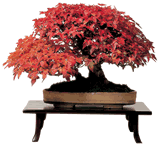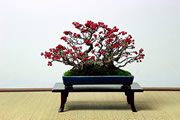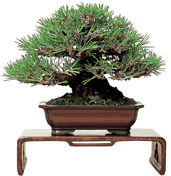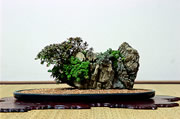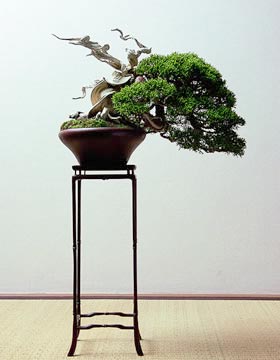|
Many tree species are grown as bonsai in Japan. Some of the most famous bonsai are evergreen conifers, especially pine and Japanese cedar. These types are popular because they live long and develop a distinctive character. Broadleaved deciduous trees like zelkova and Japanese maple are admired for their seasonal changes, from swelling buds to mature leaves to autumn colors then bare branches. Cherry, apple and other fruit trees are enjoyed for their blossoms and fruit. Over the last few years, wild plants other than trees have become popular as an easy-to-grow bonsai spin-off. In other parts of the world, enthusiasts tend to choose tree species that do well in their own climate.
In nature, trees shape themselves according to their genetic makeup and surroundings. In bonsai, the idea is to shape the tree to look like it grew in nature. For example, you might want a Japanese cedar or zelkova tree to grow upright, with a thick root base and tapering trunk. A pine or persimmon tree, on the other hand, might look better growing at an angle, as if it were shaped by the wind or forced to one side by some object near its base. One of the fascinations for bonsai hobbyists is to shape the tree so it looks, except for size, like it is growing in nature. The photos on this page show some bonsai species and shapes.
Growing a bonsai involves different steps and techniques. You will want to prune off branches that serve no useful purpose, and try to achieve a certain balance. You may have to wrap wire around the trunk and branches, to change their direction or eliminate some unnatural bend. Every effort to shape the tree takes advantage of the tree's natural ability to grow. You will also have to periodically change the soil, cut off old roots, promote the growth of thin, water-absorbing roots, and transplant the tree to revitalize it.
There is no need to think of bonsai as something terribly complicated. Just choose some variety you like, and begin growing your own.
Shinpaku (Chinese juniper). The tree cascades down one side of the pot, like a juniper on a cliff, overhanging a valley.
|
|
|
